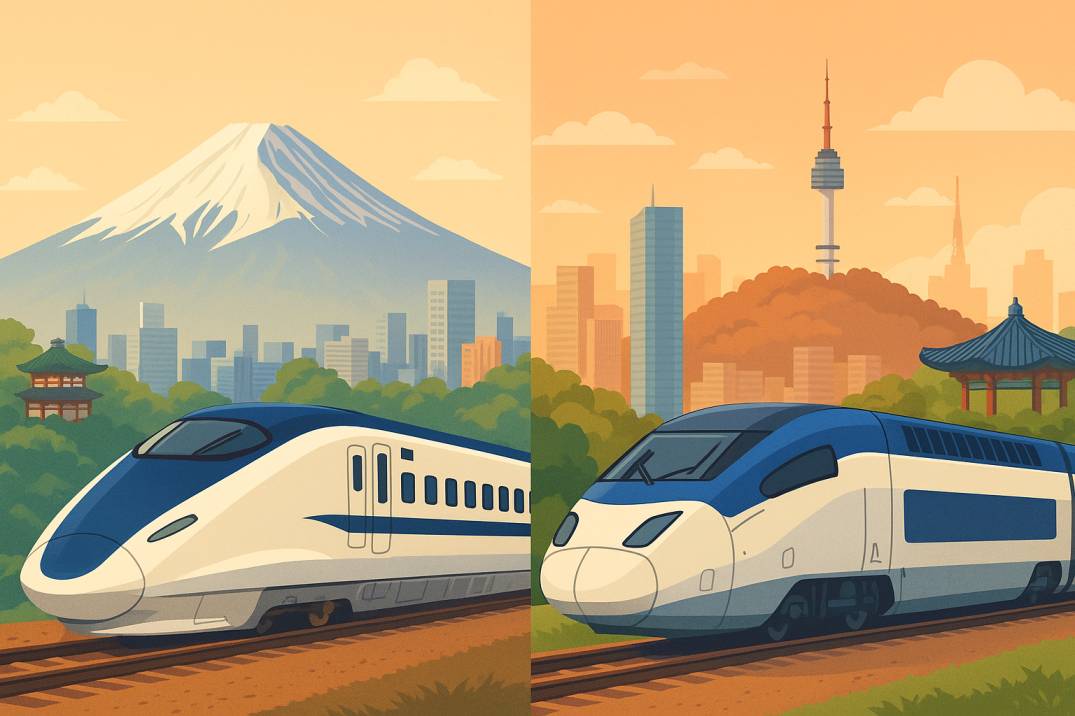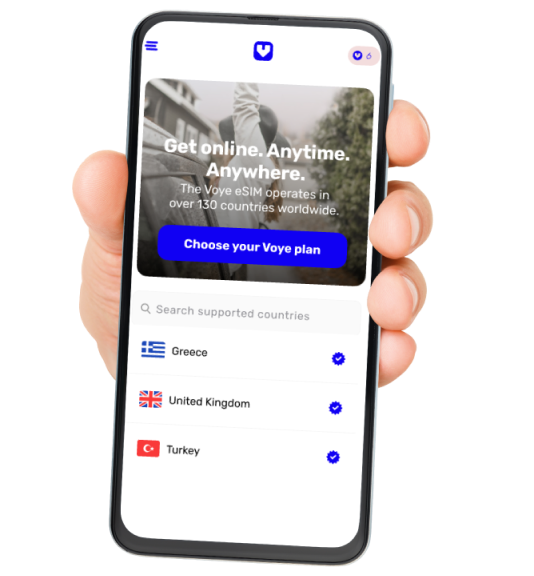Japan Rail vs. Korea’s KTX: A Train Journey Experience Comparison

Bullet Train Reviews, Scenic Routes, and the Power of Staying Connected with a Voye eSIM
Racing through futuristic cities, quiet countryside, and even through buildings, high-speed trains in Japan and South Korea aren’t just modes of transport—they’re travel experiences in themselves. The Shinkansen and KTX are engineering marvels, cultural symbols, and vital links that connect the region’s past and present.
In this guide, we dive deep into what makes Japan Rail and Korea’s KTX unique, explore lesser-known train journeys, explain how to book in advance, and show why a Voye Global eSIM is your smartest travel companion onboard.
Japan Rail (Shinkansen): The World’s Benchmark in Rail Precision
Japan’s Shinkansen isn’t just a train—it’s a national pride. Launched in 1964 to coincide with the Tokyo Olympics, it revolutionized travel in Asia and the world. Today, it spans over 2,700 kilometers, connecting cities from the snowy north of Hokkaido to the southern tip of Kyushu.
Not Just Speed, But Experience
- Punctual to the second: The average delay per train is under one minute annually.
- Seamless silence: Despite reaching up to 320 km/h, the ride is smooth and whisper-quiet.
- Seats that rival airlines: Spacious legroom, clean interiors, and reclining comfort.
Scenic Routes & Hidden Highlights
- Mount Fuji from the Tokyo–Nagoya–Osaka line is a legendary view—sit on the right-hand side.
- Sea of Japan route: On the Joetsu and Hokuriku lines, watch dramatic coastlines and snowy villages pass by.
- Sanyo Shinkansen to Hakata: Dive into the heart of samurai country with cultural gems in Okayama and Hiroshima.
Did You Know?
- Shinkansen drivers wear white gloves and undergo extensive daily safety rituals.
- Trains never cross roads: The entire network is grade-separated—no level crossings.
- Doctor Yellow: A special yellow bullet train scans tracks for imperfections. It’s rarely seen by the public, making sightings legendary.
Stay Connected from Tokyo to Seoul
No SIM swaps, no roaming fees. With Voye Global’s eSIM, you’ll have instant mobile data for booking trains, navigating stations, and staying online throughout Japan and Korea.
Korea’s KTX: A Symbol of Modern Mobility
Launched in 2004, Korea’s KTX (Korea Train Express) connects major cities in record time. Unlike Japan’s long rail-building history, South Korea’s KTX is a testament to rapid development and sleek innovation.
Efficient and Accessible
- Top speeds of 305 km/h across a compact, modern country.
- Frequent trains between Seoul and Busan—some under 2.5 hours.
- Smart interiors with USB ports, food trolleys, and digital information panels.
Unique Scenic Routes
- Seoul to Busan: The most popular route takes you past rice paddies, urban skylines, and fishing villages.
- Gangneung Line: This route to Korea’s east coast is perfect during cherry blossom season or in winter when snow blankets the countryside.
- KTX-Sancheon: A quieter, more local variant, great for scenic slow rides with fewer crowds.
Fascinating Facts
- Train through a building: In Seoul’s Yongsan District, parts of the rail system pass directly under a shopping complex.
- Themed trains: Korea has hosted “K-Pop Trains,” book-themed compartments, and even live music cars.
- Zero accidents: KTX has an impeccable safety record despite high speeds and tight schedules.
Regional eSIM for Asia Travel
Visiting both Japan and South Korea? Our Asia Regional eSIM covers multiple countries in one simple setup—perfect for cross-border rail journeys.
Booking Tickets in Advance: Stress-Free with eSIM Support
Booking a bullet train in Japan or Korea doesn’t have to be a race against the clock. But during holiday seasons, seats fill fast—and that’s where having real-time mobile access via an eSIM is a game-changer.
How to Book Japan Rail Tickets
- Japan Rail Pass: Order online before you arrive in Japan. It’s valid for most Shinkansen and regional JR trains.
- SmartEX app & JR East app: Allows online booking and seat selection.
- Green Cars: Japan’s equivalent of first class. Worth it on long journeys for quiet, plush rides.
How to Book KTX Tickets
- KorailTalk App: Korea’s national rail app supports English and allows bookings up to 30 days in advance.
- KTX Pass: Available to foreigners, offering unlimited rides for a set number of days.
eSIM Booking Benefits
- Get alerts for train delays or cancellations.
- Check seat availability and make last-minute changes.
- Use mapping apps to navigate stations—some of which are as large as airports.
Connectivity Onboard: Don’t Rely on Patchy Wi-Fi
Japan Rail Wi-Fi
- Limited on older trains.
- Available on Tokaido, Sanyo, and Kyushu Shinkansen lines—but expect dead zones in tunnels.
- Backup: A Voye eSIM keeps you connected even underground.
KTX Wi-Fi
- Present in most trains but often with usage limits.
- Public Wi-Fi is sometimes throttled or region-locked.
- A mobile eSIM guarantees better speed and no interruptions while uploading photos or navigating your next stop.
Country eSIM or Regional eSIM—What’s Right for You?
Country eSIMs
- Best for travelers spending their full trip in either Japan or Korea.
- More affordable and tailored to local carriers.
Regional Asia eSIM
- Ideal for multi-country trips (Japan, Korea, Taiwan, Thailand, Singapore, etc.)
- One setup, multiple destinations. No re-installation or extra QR scans required.
- Great for digital nomads and tourers.
Skip Airport SIM Lines
Touch down, connect instantly. Voye eSIMs activate via QR code in minutes—no more hunting for kiosks or dealing with language barriers at local shops.
Unique Rail Experiences You Shouldn’t Miss
Japan
- Hayabusa Shinkansen: One of the fastest in Japan, linking Tokyo with Hokkaido. Watch it couple with another train mid-journey.
- Romancecar: A luxury express train with panoramic front-facing seats, running from Tokyo to Hakone.
- Sagano Scenic Railway: A slower, old-fashioned route through Kyoto’s forested valleys—especially popular in autumn.
Korea
- KTX-Eum: Newer semi-high-speed trains focused on energy efficiency and comfort.
- DMZ Train: A tourist train heading toward the demilitarized zone—an eerie and historic ride.
- O-Train & V-Train: Designed for scenic travel through Korea’s mountainous center, featuring large windows and commentary.
Final Thoughts: Two Systems, One Seamless Way to Travel
Japan Rail and Korea’s KTX are masterpieces of speed, design, and national pride. Japan brings ritualistic efficiency and cultural immersion; Korea offers accessibility, sleek comfort, and urban flair.
Whichever you choose, a Voye Global eSIM ensures your journey is always in sync—whether you’re booking tickets mid-flight or translating menus at the station cafe. No queues, no plastic SIMs, no stress—just data when and where you need it.
Voye Global: Powering Your Journey Through Japan and Korea
1. Connect Before You Fly
Activate your Japan or Korea eSIM before landing. Skip the airport SIM kiosks and head straight to your train.
Buy Japan eSIM →
Buy Korea eSIM →
2. Need Multi-Country Coverage?
Our Asia Regional eSIM works across major travel hubs—from Tokyo and Seoul to Bangkok and Taipei.
Explore Asia eSIM →
3. Why Travelers Trust Voye
- Instant QR code activation
- High-speed data across top Asian carriers
- No hidden roaming fees or contract lock-ins
FAQs: Travel, Trains, and Staying Connected
Can I book Shinkansen and KTX trains from overseas?
Yes, both systems allow for international bookings via websites and apps. You’ll need a working internet connection—eSIMs make this seamless.
Do I need a different eSIM for Japan and Korea?
You can choose either separate country eSIMs or a regional Asia eSIM that covers both and more.
Can I use eSIMs to check train maps and transfer stations in real time?
Absolutely. eSIM data supports all your favorite apps—Google Maps, HyperDia, Naver Map, KakaoMetro, and more.
What’s the coolest train fact from each country?
In Japan, there’s a train cleaning crew that can clean and prep a Shinkansen in 7 minutes flat.
In Korea, some KTX routes literally pass underneath high-rise buildings—an urban design marvel.












